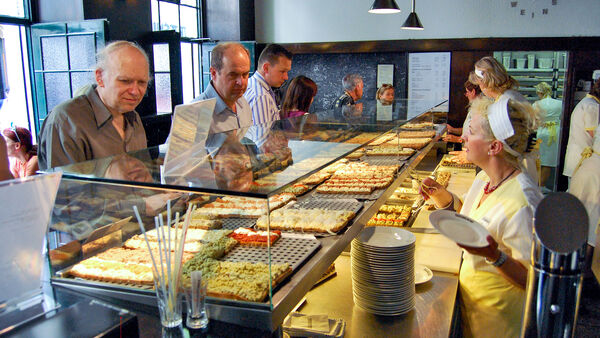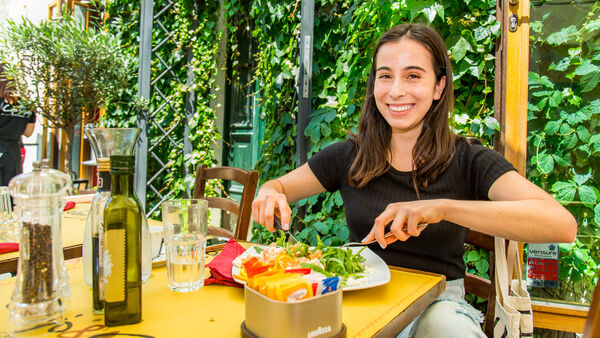Tips for Vegetarians in Europe


By Rick Steves
How hard is it to eat meat-free in Europe? Oddly enough, I've heard as many Europeans complain that America is a tough place to be a vegetarian as I've heard American vegetarians say that Europe is more challenging. Of course, both regions span a wide range of cultures and cuisines — the vegetarian scene differs just as much between, say, London and an alpine village as it does between L.A. and small-town Texas. But the main difficulty for veggie travelers isn't so much inherent to any locale, it's that you're simply not at home, where you can easily cook for yourself, and where you're already familiar with your favorite spots in town.
The good news is that vegetarianism is hardly unfamiliar anywhere in Europe. It's even significantly more common in several countries (including Switzerland, Germany, Austria, Sweden, Italy, and the UK) than in the US. There aren't really any corners of Europe where it's that tough to find enough vegetarian options to keep you fueled, so don't let your diet limit your itinerary. And now that people everywhere are coming to understand the giant environmental impact of meat production, it's safe to assume that it will only get easier to eat meat-free on the road.
For now, here are a few tips for happy vegetarian (or even just less-carnivorous) travels:
Go big at breakfast. In northern countries where meat is usually an option in hotel breakfasts, it's easy enough to load up from the buffet on yogurt, eggs, cheese, and oats. British and Irish B&B hosts are used to cooking up meat-free "fry ups" on request. Continental breakfasts, more common in the south, are normally meatless anyway, but can be skimpy, particularly on the protein (consider hitting the corner store for yogurt, or other supplements, before heading out for the day).
Get hip to picnics. Meat-free picnic lunches are easy, cheap, and a wonderful way to sample Europe's delicious fresh bread, regional cheeses, and antipasto specialties available in neighborhood bakeries, delis, and supermarkets. European supermarkets generally do a better job with prepared foods than we're used to — especially in Britain and the rest of northern Europe, where you can expect fresh packaged salads and veggie/grain dishes. Health-food stores, widely labeled with "bio" or some variation on "biological" (European code for "organic"), are also a good source for snacks and light meals.
Keep your daypack stocked with snacks. Even carnivores are smart to keep some snacks on hand, so that hunger pangs won't derail your sightseeing or drive you to settle for a mediocre meal. The greater your dietary restrictions, the more important it is to stock your daypack with a few healthy snacks (such as nuts, carrots, and energy bars).
Enjoy meat-free street food and cheap eats. Throughout Europe, you're rarely far from take-out pizza or a neighborhood kebab stand serving falafel. In Spain, tapas bars include plenty of tasty meatless nibbles, and in Greece, hearty salads rich with olives and feta are ubiquitous. Cheese, spinach, and/or potato-filled burek (a.k.a. börek) pastries are everywhere throughout the Balkans and Turkey, as are pierogi in Poland (and throughout northern central Europe). Cafeterias, such as the cheery, freshly stocked ones that commonly take up the top floor of major department stores, are a particularly good option, since you can see exactly what you're getting and select an assortment of foods that suit your diet.
Research your restaurants. It's in standard dining environments where your patience may be minced. For a good meal, seek out a vegetarian restaurant (most big cities have a few; use sites/apps like HappyCow for listings and reviews). Most guidebooks, including mine, make a point of listing at least one local-favorite vegetarian place in each city, where possible. (Take crowd-sourced advice with a grain of salt — a TripAdvisor user's idea of "vegetarian friendly" might not match yours.) Areas with a health-food culture tend to have more vegetarian-friendly restaurants, particularly in many Swiss and Scandinavian cities, where it's fairly easy not just to eat meat-free, but eat well. Indian restaurants, with their myriad vegetarian dishes, are especially common in Britain (and, increasingly, in pockets of Switzerland popular with South Asian tourists). Many German cities have one or two upscale Turkish restaurants with tasty meatless fare.
Almost anywhere you go, it's usually safe to assume that a fine-dining restaurant will have at least one good vegetarian entree — but browsing menus online could be worthwhile, especially if you're looking to avoid yet another cheese-heavy meal. Look for "(v)" on menus (which may mean "vegan" — check the fine print), or, as on packaged foods, the standard European vegetarian symbol (a green V with a leaf).
Watch out for restaurant servers who think "vegetarian" means "no red meat" or "not much meat." Keep in mind that some cuisines tend to blend ingredients more than others — e.g. it's not hard to just order a Biergarten potato salad and skip the wurst, but good luck picking the beef out of your spaghetti olognese. Just like at home, nominally plant-based dishes like lentils may well have been cooked with chicken stock. If you're a strict vegetarian, you'll want to make things very clear. Write out the appropriate phrase (see sidebar, or your translation app), keep it handy, and show it to each waiter before ordering.
If you eat fish, read up on ethical options. Pescatarians can eat very well in Europe, and not just in coastal areas. Freshwater fish is common in many inland regions — some of the tastiest fish I've ever tucked into was in Switzerland and Austria. But overfishing is as big a problem in European waters as elsewhere, and even waterfront restaurants commonly serve imported seafood. When ordering, ask what's local and in season — while that doesn't guarantee it was caught sustainably, it's a start.
Despite a growing appetite for sustainable seafood, resources are still paltry for ethically minded fish fans. If you'll be traveling in the UK, get the Marine Conservation Society's Good Fish Guide app. For the continent, try the World Wildlife Foundation's country-by-country sustainable seafood guides — though none are available in English, they can still be useful when viewed with an auto-translating browser (such as Chrome). Or just search "sustainable seafood" for your destination — for some locales you can find helpful advice for travelers, such as this tipsheet for Italy.
Consider self-catering accommodations, especially for vegan diets. Of course, eating well on the road is more challenging when dairy and eggs are off the table. Veganism is roughly as common in Europe as in the US, and big European cities, especially those with thriving arts scenes (London, Berlin, Prague, Amsterdam) have at least a handful of restaurants catering to a substantial vegan population. But for the sake of convenience, it could be worth looking at accommodation options that allow you to cook your own meals (Airbnb arrangements, apartment rentals, and/or hostel stays).

